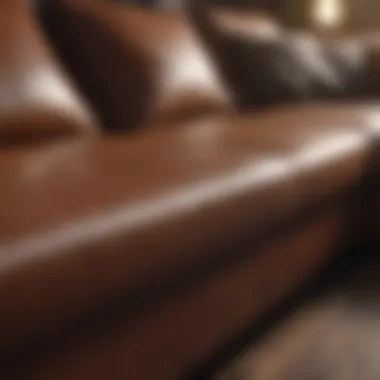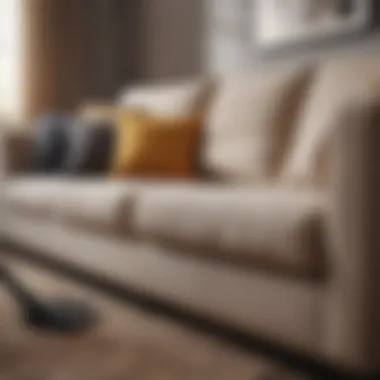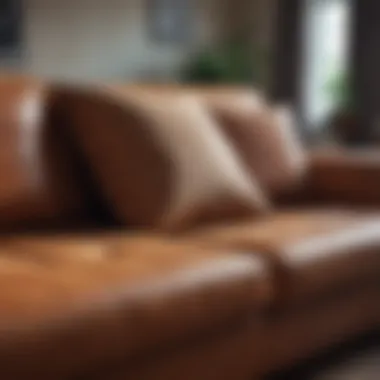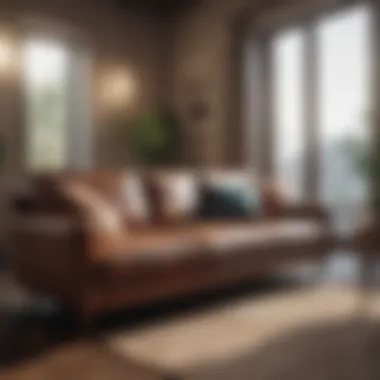Expert Sofa Cleaning Techniques for Every Material


Intro
Understanding how to clean your sofa is essential for maintaining a welcoming and comfortable living space. Upholstered furniture can be an investment of both time and money, so ensuring it's well cared for will prolong its lifespan and sustain its aesthetic appeal. From managing stains to everyday upkeep, knowing the right techniques can save homeowners considerable expenditure on replacements.
In today's guide, we will explore various approaches tailored to different sofa materials, such as fabric, leather, and microfiber, ensuring every reader finds something relevant to their specific cleaning needs. Moreover, we'll touch upon preparation steps, which are crucial in setting up a successful cleaning routine. Understanding your sofa's fabric is akin to knowing the rules of the road when driving; without this knowledge, you're at risk of serious mishaps.
Cleaning your sofa isn’t just about removing stains—it's about preserving the essence of your home and creating a sanctuary that reflects your personal style. Let's delve into the key techniques that will keep your seating looking sharp and fresh, allowing you to sit back and enjoy your cozy corner of the world.
Foreword to Sofa Care
When it comes to maintaining a comfortable and inviting living space, the sofa often plays a starring role. It’s not just a piece of furniture; it’s a gathering spot, a refuge after a long day, and sometimes even a makeshift bed for unexpected guests. Therefore, understanding how to care for this essential element of your home is paramount.
Keeping your sofa clean isn’t merely about aesthetics—though a fresh-looking piece definitely enhances your ambiance—it’s about prolonging the life of your furniture and safeguarding your health. Sofas can easily amass allergens, dust, and grime over time, potentially leading to respiratory issues and other health concerns. Regular cleaning also prevents the buildup of unpleasant odors, ensuring that your sofa remains a welcoming spot.
While it might seem trivial, the importance of regular sofa maintenance cannot be overstated. Think of it as giving your furniture a health check. By incorporating straightforward cleaning routines into your home care regimen, you stand to enhance the durability of your upholstery significantly. Not only does this protect your investment, but it also saves you money on costly repairs or replacements down the line.
In addition, proper care can ensure that your sofa remains a centerpiece in your home decor for years to come. Given the various materials that sofas come in, understanding how to maintain each type is essential. Some need more care than others, and the right techniques vary significantly.
Understanding the Importance of Regular Cleaning
Sofa care is often pushed to the back burner for many. Life gets busy, and some folks might even prefer to keep the sofa covered rather than clean it regularly. However, prioritizing regular cleaning has its merits.
For starters, cleaning your sofa regularly increases its longevity. Think about it: every time you sit down, oils from your skin, food particles, and dust mites find their way into the fabric. A good clean every now and then can rid your sofa of these unwelcome guests.
Additionally, a clean sofa creates a healthier environment. The hidden debris can trigger allergies and allergies in sensitive individuals or pets. Regular vacuuming and spot cleaning can help mitigate these risks.
Moreover, a clean sofa looks better. An unkempt sofa can make your whole living area seem cluttered or shabby, even if the rest of your home is pristine. A swift maintenance routine can preserve the visual appeal of your space.
"An ounce of prevention is worth a pound of cure." This saying holds true as much for sofas as for health; investing time in keeping them clean saves trouble later.
Identifying Different Sofa Materials
Not all sofas are created equal. They come in various materials, ranging from durable fabrics to opulent leathers, and even synthetic fibers. Knowing the different types is crucial for effective cleaning.
- Fabric: These sofas range from cotton blends to performance fabrics, each requiring different care methods.
- Leather: A touch of elegance, leather sofas need special care to maintain their suppleness and shine.
- Microfiber: Known for its stain-resistance, this material still requires regular upkeep to stay looking new.
- Vinyl and Faux Leather: More straightforward when it comes to cleaning, these materials still benefit from occasional maintenance.
Understanding the specific needs of your sofa material can guide your cleaning decisions and ensure you use the right methods and products without risking damage.
Preparation Steps for Cleaning
When it comes to cleaning a sofa, preparation is half the battle won. Rushing into it without strategizing can often lead to more harm than good. Taking the time to prepare lays a solid foundation, ensuring that the cleaning process is effective and that no material is damaged in the end. It not only involves gathering materials but also understanding the current state of your sofa and creating the right environment for the process.
Assessing the Condition of Your Sofa
Before you dive head-first into cleaning, a close inspection of your sofa is crucial. This step allows you to see what you're truly up against. Are there noticeable stains, wear, or tear? Knowing the condition aids in selecting the best cleaning method.
- Examine the Fabric: Get up close and personal with each section of your sofa. Look for discoloration, pet fur, or remnants of snacks that might have slipped through the cracks. This will help you tailor your cleaning approach.
- Check for Damage: Any fraying edges or ripped seams should be identified ahead of time. Some cleaning methods could exacerbate the damage.
- Identify Previous Cleanings: Has it been a while since your last clean? This info can guide the effectiveness of your chosen methods.
Once you're aware of your sofa's current state, you can better decide which supplies you'll need for its rejuvenation.
Gathering the Necessary Supplies
Equipped with the right tools makes cleaning a breeze. Think of it as preparing for a mission; you wouldn’t venture into the wild without the right gear, would you?
Mild Detergents
Mild detergents play a pivotal role in the world of sofa cleaning. They are typically plant-based and don’t contain harsh chemicals that could damage the fibers. Their gentle nature makes them a favorite among cleaning aficionados, allowing them to tackle stains without aggression. Not only do they clean effectively, but they also minimize the risk of discoloration, which is a common concern when working with delicate materials. Just keep in mind that while they are excellent for regular cleaning, stubborn stains may require a more robust solution.
Soft Cloths or Brushes
Having soft cloths or brushes at hand is non-negotiable for anyone serious about cleaning their sofa. The main charm of these tools lies in their capacity to agitate dirt without scratching or damaging the fabric. Unlike rough or abrasive materials that could lead to more harm, these softer options allow for a thorough clean while still respecting the integrity of the materials. Be sure to choose between cotton cloths or gentle brushes, depending on your sofa's fabric; it's a nuanced decision that can greatly impact your success.
Buckets and Non-Abrasive Sponges
Buckets are often underappreciated yet they can be crucial in sofa cleaning. Having one handy allows you to mix cleaners and rinse sponges without running back and forth from the sink. Non-abrasive sponges, on the other hand, enhance this process further. They are designed specifically to lift dirt without scratching surfaces. Opting for sponges that are easy to rinse and clean ensures you maintain the best cleaning environment and avoid pushing grime deeper into the fabric.


Preparing the Cleaning Area
Cleaning isn’t just about the sofa; it's also about the space around it. Preparing your cleaning area is like setting the stage for a performance. You need to ensure everything flows smoothly.
- Clear the Space: Move any coffee tables, chairs, or other obstructions out of the way. This not only makes cleaning easier but also protects your belongings from accidental splashes.
- Lay Down Protective Covers: If you’ve got wooden or carpeted floors, consider using old sheets or towels to avoid any slipperiness due to spills.
- Ventilate the Area: Open a window or turn on a fan. The fresh air will help dissipate any odors from cleaning products, leaving your space smelling fresh and lively.
Having these preparations laid out ensures that nothing catches you off guard. The next steps will be methodical and effective, turning the chore of sofa cleaning into a productive endeavor.
Cleaning Techniques Based on Material Types
Understanding how to clean a sofa effectively is paramount due to the increasing variety of materials used in upholstery. Each type of material requires tailored cleaning methods and products to ensure they retain their look and longevity. Improper cleaning techniques can lead to irreversible damage or dulling, which is particularly concerning for those who view their furniture as an investment. This section dives into the specific cleaning techniques applicable to various sofa material types, offering insights that enhance the cleanliness and lifespan of your upholstery.
Fabric Sofas
Spot Cleaning Techniques
Spot cleaning is a home-run choice when addressing localized stains on fabric sofas. The essence of spot cleaning is to target only the soiled area without committing to a full clean. This is particularly useful for minor mishaps, like a dark coffee spill or remnants from an unexpected snack attack.
Key Characteristics:
One standout feature of spot cleaning is its immediacy. When a spill occurs, acting fast can often prevent a stain from setting in. Common solutions include mild detergent mixed with warm water, applied gently with a soft cloth. The beauty of this technique is that it's quick and accessible.
Advantages:
- Preserves the integrity of the entire fabric by avoiding unnecessary saturation.
- Saves time, especially for small, frequent cleaning tasks.
- Can be done with household items that are often at hand.
Disadvantages:
- Only addresses visible stains, which means deeper dirt may go unnoticed and linger.
- Requires a good eye for identifying the right cleaning agent for specific fabric types.
Steam Cleaning Method
Steam cleaning emerges as another effective cleaning strategy for fabric sofas. This method relies on high-temperature steam to lift dirt, allergens, and bacteria from the fabric fibers.
Key Characteristics:
A key trait of steam cleaning is its ability to sanitize without chemical agents. The hot steam penetrates and loosens grime, making it simpler to wipe away.
Advantages:
- Ideal for a deeper clean, which helps eliminate odors and any dust mites residing in the fabric.
- Eco-friendly solution, as it doesn't require detergents or harsh chemicals.
Disadvantages:
- Use of steam can potentially harm delicate fabrics that aren't designed to handle heat.
- Equipment can be costly to purchase or rent, making it a less attractive option for infrequent users.
Leather Sofas
Cleaning and Conditioning Leather
Cleaning and conditioning leather is crucial due to its porous nature, which can absorb oils and dirt over time. Regular maintenance not only cleans but also nourishes the leather, extending its lifespan.
Key Characteristics:
A standout aspect of this method includes the dual purpose of cleaning and feeding the leather. Special leather cleaners paired with conditioners help maintain the suppleness of the material.
Advantages:
- Helps retain the original luster and softness of leather over time.
- Prevents cracking and drying, which can occur without proper care.
Disadvantages:
- Requires specific products that can be more costly than general cleaners.
- Some cleaning agents might slightly alter the leather’s color.
Common Leather Stain Removal
The identification and removal of common leather stains is another critical aspect of maintenance. Whether it's the oily fingerprint from a relaxed hand or the smear of pen ink, knowing how to treat these stains promptly can save a lot of heartache.
Key Characteristics:
This technique emphasizes the importance of a tailored approach for different stains. For instance, using a damp cloth with a little soap can work wonders for fresh stains.
Advantages:
- Immediate action can prevent permanent marks or discoloration.
- Many stains can be treated with common household items, making it accessible.


Disadvantages:
- Misapplication can worsen the stain or damage the leather.
- Not all stains can be easily lifted and may require professional intervention.
Microfiber Sofas
Safe Cleaning Solutions
Microfiber sofas are loved for their plush feel and durability, but they require specific cleaning solutions to maintain their integrity. The key here is the use of mild detergents or microfiber-specific cleaners that don’t harm the delicate fibers.
Key Characteristics:
This method’s primary feature is the composition of cleaners, often formulated to lift dirt while being non-invasive to the fabric’s texture.
Advantages:
- Typically, only minimal water is needed, reducing drying time significantly.
- You maintain the soft feel without compromising the fabric.
Disadvantages:
- Some products can be pricey and less accessible.
- Requires regular application to keep the fabric looking pristine.
Brushing Techniques for Maintenance
Maintaining microfiber sofas can benefit from routine brushing, which helps to realign the fibers and prevent matting. This easy technique can do wonders for daily upkeep.
Key Characteristics:
Brushing not only cleans but also acts to restore texture. Using a soft brush with gentle bristles can keep the fabric looking fresh.
Advantages:
- Quick and easy to do, requiring no solution besides water.
- It serves both cleaning and maintenance purposes.
Disadvantages:
- Might not replace deeper cleaning methods for extensive dirt accumulation.
- Some brushes may leave residue if not chosen wisely.
Vinyl and Faux Leather Clean-Up
Detergent Application Techniques
When it comes to vinyl and faux leather, proper detergent application can refresh and restore these materials effectively. These surfaces often retain their visual appeal longer if maintained well.
Key Characteristics:
Detergents formulated for synthetic materials work wonders here, as they lift dirt without damaging the surface.
Advantages:
- Quick cleaning process, making it approachable for busy lifestyles.
- Detergents are usually economical and easy to find.
Disadvantages:
- Overuse may lead to cracking over time due to harsh chemicals.
- Requires careful rinsing to avoid residue buildup.
Protection from Scratches
Vigilance against scratches is a vital part of dealing with vinyl and faux leather. Fortifying furniture with protective coverings can keep unsightly marks at bay.
Key Characteristics:
Dedicated protectants, such as sprays or guards, form a barrier against potential scratches, extending the function of your upholstery.
Advantages:
- Prevention is often easier than repair.
- Helps maintain the visual aesthetics over time.
Disadvantages:
- Some coatings can alter the texture and feel of the material.
- Requires periodic reapplication to uphold effectiveness.
Dealing with Specific Stains


Stains, as pesky as they can be, tell a story—sometimes it’s a tale of a family dinner gone awry, while other times it reveals a weekend of fun with furry companions. Knowing how to deal with various stains can save your sofa from eternal shame and maintain its charm. Tackling specific stains isn’t just about cleaning; it’s about preserving the integrity and aesthetics of your upholstery.
Food and Drink Stains
When that lasagna or glass of red wine takes a tumble onto your beloved sofa, don’t panic. Instead, approach the stain with a steady hand and a clear head. Food and drink stains can feel like a real nightmare, but most can be managed if handled pronto.
- Immediate action is key. The sooner you address the situation, the less chance the stain has to set in. Blot the area with a clean cloth—don’t rub, as it can spread the stain.
- Identify the culprit. Different foods and drinks require different treatment. For example, greasy stains from potato chips might need a degreaser, while tomato sauce can be tackled with warm water and soap.
- Use mild solutions. A mixture of cool water and gentle detergent often works wonders. Applying this to the stain, followed by a light blotting action, can lift it right out.
Stains are an inevitable part of life, but knowing how to handle them gives you the upper hand.
Pet-Related Issues
For pet owners, sofas can sometimes double as playgrounds or snooze stations, leading to a range of stains and odors that can be daunting. Dealing with pet-related issues means being prepared for anything from mud tracks to the occasional hairball.
- Act fast and be prepared. If you notice an accident, clean up as soon as you can. Paper towels are good for blotting up liquids, while a rubber glove can quickly gather fur in a pinch.
- Keep cleaning supplies handy. A pet odor neutralizer is worthwhile to have at home; they not only get rid of the stain but also combat lingering smells that attract your pet back to the same spot.
- Regular grooming helps. You might not realize it, but brushing your pet frequently can minimize fur accumulation on your sofa. A lint roller can quickly pick up stray hairs when guests are on their way over.
With a bit of forethought, pets and upholstery can coexist happily.
Ink and Dye Transfers
Ink stains can be trickier than they seem. Those charming ballpoint pens may seem innocent, but they can turn into little fiends, leaving behind traces of ink that read like a budget novel gone wrong. Likewise, dye from jeans or any colored items can transfer onto your sofa when you're least expecting it.
- Identify the stain quickly. First things first, don’t let it linger. Blot the area with a clean, dry cloth to absorb as much ink as possible.
- The rubbing alcohol trick. For ink, rubbing alcohol can work miracles. Dab a little bit on a cotton ball and carefully apply it to the stained area. Always test this on an inconspicuous spot first to ensure no damage occurs.
- Dye stains require immediate care. Treat these with a mixture of vinegar and water—it often helps to lift the dye without damaging the fabric.
Remember, every sofa and stain is unique, so sometimes you might need to try a few different methods.
"Stains are just stories waiting to be cleaned. Give them a new ending."
Best Practices for Preventive Maintenance
Maintaining the look and feel of your sofa is not just about responding to stains after the fact. It’s about nurturing your piece of furniture with gentle, routine care. Establishing best practices for preventive maintenance can save you time, effort, and money in the long run while ensuring your sofa remains a centerpiece in your living space. By adopting these systems, you can significantly extend the lifespan of your upholstery and keep it looking fresh.
Routine Cleaning Routines
A regular cleaning routine is vital for preserving your sofa's elegance and hygiene. Aim for a light cleaning every week, which can be as simple as using a soft brush or a vacuum equipped with a brush attachment to eliminate any accumulated dust and dirt. This step is essential, especially in households with pets or kids, where dirt seems to find a home!
- Vacuuming: Regularly vacuuming helps prevent dirt buildup and maintains the fabric's integrity. Ensure that you pay attention to corners, seams, and under cushions where crumbs often hide.
- Dusting: Using a soft, lint-free cloth to lightly wipe down any surfaces that can attract dust will prevent particles from embedding in the fibers.
- Fluffing Cushions: Giving cushions a good fluff helps maintain their shape and ensures they don’t become flat over time. Rotate them occasionally for an even wear.
By sticking to a weekly cleaning schedule, you’ll not only find the sofa stays cleaner, but you can also sidestep major deep-cleaning efforts down the road.
Stain Protection Solutions
Proactive measures against staining are crucial for a sofa’s durability. A trained eye can spot potential trouble areas and deal with them before damage occurs. Consider applying a stain repellant to your upholstery when it’s new. Not all fabrics will respond to it, so it helps to read up on the material beforehand. Here are a few effective approaches:
- Spray-on Protectors: Brands like Scotchgard offer easily applied solutions that create a barrier against moisture and stains. Ensure to follow the manufacturer’s instructions for best results.
- Covers and Slipcovers: Fabric or leather covers can be a practical option for preventively warding off stains and easier cleaning. They're especially useful in high-traffic areas or homes with pets.
- Seasonal Treatments: For leather sofas, consider using a conditioning cream, which not only provides a barrier from stains but also prevents the leather from drying and cracking.
Regular application of protective solutions can minimize significant damages and make cleaning less of a chore.
Lifestyle Adjustments to Minimize Damage
Adapting your lifestyle and habits can significantly lessen the amount of wear and tear on your sofa. Some strategies are straightforward, while others might require a bit more thought.
- Designated Eating Areas: Avoid the practice of snacking on the sofa or the risk of inevitable spills. Having a designated area for meals can keep crumbs and drips out of your living room.
- Remove Shoes: A simple yet effective method involves having a no-shoe policy on the couch. It cuts down on dirt and mud being tracked onto upholstered surfaces.
- Control Sunlight Exposure: Too much sun can fade colors and degrade fabric. Using curtains or blinds to limit direct sunlight can help maintain your sofa's vibrancy.
- Regular Check-ups: Sometimes, the most minor frays or loose threads can betray the longevity of your sofa. Stay vigilant and fix any issues as soon as they arise.
By weaving these habits into your daily life, you create a protective cocoon for your sofa, preserving its value and aesthetics. Effective preventive maintenance techniques don’t just make cleaning easier, they reassure you that your cherished furniture will remain a proud feature of your home for years to come.
End
In the realm of home maintenance, sofa upkeep often takes a backseat. However, as explored throughout this guide, maintaining your sofa is more than just a chore; it's an essential step to ensuring the longevity and aesthetic appeal of your living space. Regular and effective cleaning not only prolongs the life of your couch but also contributes to a healthier indoor environment, free from dust and allergens. The importance of understanding the specific materials your sofa is made from cannot be overstated—each type requires tailored cleaning methods to avoid damage.
Recap of Key Cleaning Insights
To distill the wealth of information provided, here are the key insights:
- Regular Maintenance: Routine cleaning helps in keeping the sofa looking new. A simple vacuum every week can remove debris before it settles deep into the fabric.
- Material Awareness: Knowing whether your sofa is leather, fabric, or microfiber directly affects how you treat it. Each material has its own set of challenges and best practices for cleaning.
- Handling Stains Promptly: Quick action can be the difference between a minor inconvenience and a lasting blemish. For example, food stains should be treated immediately to avoid setting.
- Use of Appropriate Products: Always opt for cleaning agents that suit your sofa's fabric type. Harsh chemicals can lead to color fading or texture damage, negating all your hard work.
- Preventive Measures: Applying stain-resistant treatments and using decorative throw covers can help shield your sofa from damage. A stitch in time saves nine, as they say.
"Investing a little time in sofa care can yield great returns in durability and comfort."
Encouragement for Regular Care
Caring for your sofa is an ongoing commitment, yet it doesn't have to be overwhelming. Break it down into manageable tasks, such as establishing a monthly deep-cleaning routine and incorporating spot cleans as needed. Just like tending to a garden, regular maintenance can transform what might seem a daunting task into an enriching part of homeownership.
The benefits of a well-kept sofa extend beyond its appearance. It creates a welcoming atmosphere, enhancing your living space's comfort and functionality. After all, each couch is often the central gathering point of family life, from movie nights to cozy reading corners.















